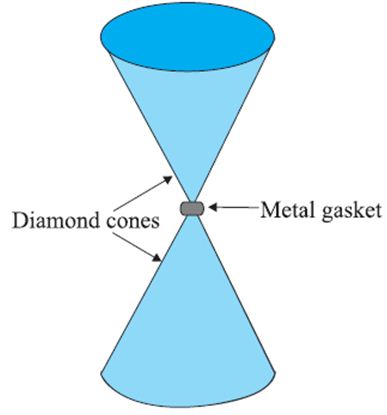Kinetic Theory - Online Test
Q1. What is the average kinetic energy of the helium atoms in a balloon of diameter 30.0 cm at 20.0C and 1.00 atm?
Answer : Option B
Explaination / Solution:
K¯=32kT=32×1.38×10−23×293=6.07×10−21J
Q2. What is the root-mean-square speed of helium atoms in a balloon of diameter 30.0 cm at 20.0C and 1.00 atm?
Answer : Option B
Explaination / Solution:
vrms=3RTM−−−−√=3×8.31×2934×10−3−−−−−−−−√=1351m/sec=1.35Km/sec
Q3. A cylinder contains a mixture of helium and argon gas in equilibrium at 150C. What is the average kinetic energy for each type of gas molecule?
Answer : Option A
Explaination / Solution:
Average KE depends only on temperature
Q4. Anvils made of single crystals of diamond, with the shape as shown in Figure, are used to investigate behaviour of materials under very high pressures. Flat faces at the narrow end of the anvil have a diameter of 0.50 mm, and the wide ends are subjected to a compression force of 50,000 N. What is the pressure at the tip of the anvil?


Answer : Option C
Explaination / Solution:
No Explaination.
Q5. Calculate the change in internal energy of 3.00 mol of helium gas when its temperature is increased by 2.00 K.
Answer : Option D
Explaination / Solution:
Helium is a monoatomic gas.(CV = 1.5R)
change in internal energy
Q6. One mole of hydrogen gas is heated at constant pressure from 300 K to 420 K. Calculate the energy transferred by heat to the gas
Answer : Option B
Explaination / Solution:
Hydrogen is a diatomic gas. (CP = 3.5R)
energy transferred by heat to the gas
Q7. One mole of hydrogen gas is heated at constant pressure from 300 K to 420 K. Calculate the increase in its internal energy.
Answer : Option D
Explaination / Solution:
Hydrogen is a diatomic gas. (CV = 2.5R)
Change in internal energy
Q8. One mole of hydrogen gas is heated at constant pressure from 300 K to 420 K. Calculate the work done by the gas.
Answer : Option D
Explaination / Solution:
In isobaric process
Q9. A house has well-insulated walls. It contains a volume of 100 of air at 300 K. Calculate the energy required to increase the temperature of this air by 1.00C.
Answer : Option A
Explaination / Solution:
Q=nCPΔT=72RnΔT=72(PVT)ΔTQ=72×(1.01×105×100300)×1=118KJ
Q10. One mole of an ideal monatomic gas is at an initial temperature of 300 K. The gas undergoes an isovolumetric process, acquiring 500 J of energy by heat. It then undergoes an isobaric process, losing this same amount of energy by heat. Determine the new temperature of the gas
Answer : Option A
Explaination / Solution:
for monoatomic gas CV = 1.5R, CP = 2.5R
At const volume,
Q = 500 J
At const pressure Q = 500 J
